




Your support is critical to our success.
Accepted Scientific Name: Echinopsis backebergii Werderm. in Backeb.
Neue Kakteen 83, 84, fig. 1931 et: Fedde, Rep. Spec. Nov. 30: 64. 1932 Backeb. & Werderm.
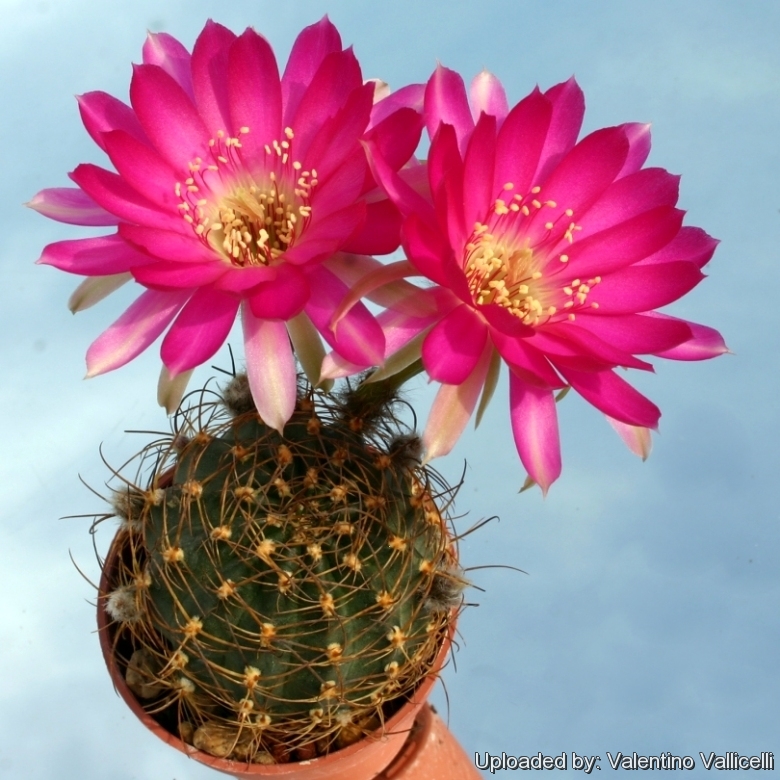
This species is one of the most remarkable Lobivia, with large, very colourful "shocking fuchsia pink" to purple-violet flowers with white centre. Everyone should have this plant.
Origin and Habitat: Peru, Huancavelica, Villa Azul altitudes about 3000 m.
Synonyms:
- Echinopsis winteriana (F.Ritter) D.R.Hunt
- Lobivia winteriana F.Ritter
- Neolobivia winteriana (F.Ritter) F.Ritter
Echinopsis backebergii Werderm. in Backeb.
Neue Kakteen 83, 84, fig. 1931 et: Fedde, Rep. Spec. Nov. 30: 64. 1932
Synonymy: 29
- Echinopsis backebergii Werderm. in Backeb.
- Lobivia backebergii (Werderm.) Blatt.
- Echinopsis backebergii subs. wrightiana (Backeb.) M.Lowry
- Echinopsis wrightiana (Backeb.) G.D.Rowley
- Lobivia backebergii subs. wrightiana (Backeb.) Rausch ex G.D.Rowley
- Lobivia backebergii var. wrightiana (Backeb.) Rausch
- Lobivia wrightiana Backeb.
- Neolobivia wrightiana (Backeb.) Y.Itô
- Echinopsis backebergii subs. wrightiana f. ollaoana
- Echinopsis boedekeriana Harden
- Cinnabarinea boedekeriana (Harden) F.Ritter
- Lobivia boedekeriana (Harden) Boed.
- Lobivia pugionacantha var. boedekeriana (Harden) J.Ullmann
- Lobivia rossii var. boedekeriana (Harden) Backeb.
- Echinopsis oxyalabastra (Cárdenas & Rausch) Mario Rodríguez Rodríguez
- Lobivia backebergii var. oxyalabastra (Cárdenas & Rausch) Rausch in Rausch
- Lobivia oxyalabastra Cárdenas & Rausch
- Echinopsis winteriana (F.Ritter) D.R.Hunt
- Lobivia winteriana F.Ritter
- Neolobivia winteriana (F.Ritter) F.Ritter
- Echinopsis zecheri (Rausch) G.D.Rowley
- Lobivia backebergii subs. zecheri (Rausch) Rausch
- Lobivia backebergii var. zecheri (Rausch) Rausch
- Lobivia zecheri Rausch
- Lobivia wrightiana f. chilensis hort. ex E.Herzog
- Lobivia backebergii var. chilensis Kníže, n.n.
- Lobivia chilensis Kníže, n.n.
- Neolobivia divaricata F.Ritter
- Echinopsis winteriana cv. Fluorescent (F.Ritter) D.R.Hunt
Description: Echinopsis winterianaSN|9502]]SN|9514]], better known as Lobivia winterianaSN|9515]]SN|9515]] is one of the many geographical form of Echinopsis backebergiiSN|9514]]SN|9502]]. Many of its morphological and geographical variant was early classified as different independent species, but nowadays all this plant are considered part of a multiform species, where each form is linked to others by populations of plants with intermediate characteristics. Echinopsis winterianaSN|9502]]SN|9514]] has distinctive bright fuchsia pink petals that contrast nicely with the with a paler or white throat. It is a very prolific bloomer, if you keep it reasonably cool and absolutely dry during winter. The species is however controversial and is now fully synonymized with Echinopsis backebergiiSN|9514]]SN|9502]].
Habit: It is a small solitary or basally branched cactus, older plants may form mats.
Stem: At first globular becoming cylindrical as it ages, diameter about 5-7 cm. Epidermis greys-green.
Ribs: 13-19 more or le spiralling.
Root: Napiform (Carrot like).
Areoles: Oval with dull white felt.
Radial spines: 6-14 short, about 4-7 mm long, thin, unequal, curved backward somehow pectinated, pale brown, yellow or amber when young, later greys.
Central spines: None or sometime 1 stouter about 1-3 cm long, darker with black tip.
Flowers: Large, funnel shaped, very colourful fuchsia pink to purple-violet, often with a bluish sheen and white throats 7,5-9 cm in diameter. Tepals lanceolate.
Fruit: About 1,5 cm in long, tannish-green to brownish-red.
Seed: Black.
Subspecies, varieties, forms and cultivars of plants belonging to the Echinopsis backebergii group
 Echinopsis backebergii Werderm. in Backeb.: has 1-11 spines, variable, unequal, about 4-50 mm long and very colourful flowers carmine-red or violet, often with white throats. Distribution: From South-east La Paz (Bolivia) to Huancavelica (Peru).
Echinopsis backebergii Werderm. in Backeb.: has 1-11 spines, variable, unequal, about 4-50 mm long and very colourful flowers carmine-red or violet, often with white throats. Distribution: From South-east La Paz (Bolivia) to Huancavelica (Peru). Echinopsis backebergii subs. wrightiana (Backeb.) M.Lowry: has long thin wispy spines and pale lilac flowers with often lighter throats. Distribution: Huancavelica, Central Peru.
Echinopsis backebergii subs. wrightiana (Backeb.) M.Lowry: has long thin wispy spines and pale lilac flowers with often lighter throats. Distribution: Huancavelica, Central Peru.- Echinopsis boedekeriana Harden
 Echinopsis winteriana (F.Ritter) D.R.Hunt: has large, funnel shaped, fuchsia pink to purple-violet flowers with white centre. Distribution: Huancavelica, Peru.
Echinopsis winteriana (F.Ritter) D.R.Hunt: has large, funnel shaped, fuchsia pink to purple-violet flowers with white centre. Distribution: Huancavelica, Peru. Echinopsis winteriana cv. Fluorescent (F.Ritter) D.R.Hunt: has colourful "shocking fuchsia pink" flowers with a bright white contrasting centre.
Echinopsis winteriana cv. Fluorescent (F.Ritter) D.R.Hunt: has colourful "shocking fuchsia pink" flowers with a bright white contrasting centre. Echinopsis zecheri (Rausch) G.D.Rowley: has harder sharp spines and rather coarser flowers with rich liliac or purple petals and a white throat. Distribution: Ayacucho, Peru.
Echinopsis zecheri (Rausch) G.D.Rowley: has harder sharp spines and rather coarser flowers with rich liliac or purple petals and a white throat. Distribution: Ayacucho, Peru. Lobivia wrightiana f. chilensis hort. ex E.Herzog
Lobivia wrightiana f. chilensis hort. ex E.Herzog
Bibliography: Major references and further lectures:
1) Edward Anderson “The Cactus family” Timber Press, Incorporated, 2001
2) James Cullen, Sabina G. Knees, H. Suzanne Cubey "The European Garden Flora Flowering Plants: A Manual for the Identification of Plants Cultivated in Europe, Both Out-of-Doors and Under Glass" Cambridge University Press, 11/Aug/2011
3) David R Hunt; Nigel P Taylor; Graham Charles; International Cactaceae Systematics Group. "The New Cactus Lexicon" dh books, 2006
4) The encyclopedia of cacti
5) Willy Cullmann, Erich Götz (Dozent Dr.), Gerhard Gröner “Copertina anteriore” Timber Press, 1984
6) Lobivia:
7) Walter Rausch “The Day Flowering Echinopsidinae from a Geographical Distribution Point of View,” Volumes 1-3 R. Herzig, 1975
8) Hans Hecht “Cacti & succulents” Sterling Pub. Co., 1997
9) Clive Innes, Charles Glass “Cacti” Portland House, 1991
10) John Borg “Cacti: a gardener's handbook for their identification and cultivation” Blandford P., 1970
11) RHS "A-Z encyclopedia of garden plants." United Kingdom: Dorling Kindersley. 2008
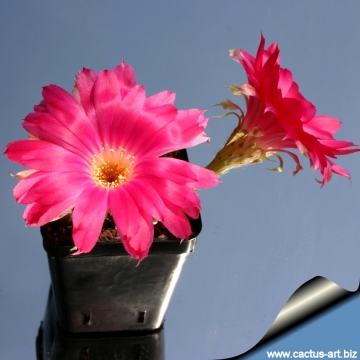
Echinopsis winteriana Photo by: Cactus Art
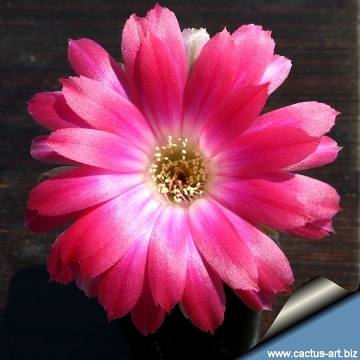
Echinopsis winteriana Photo by: Cactus Art
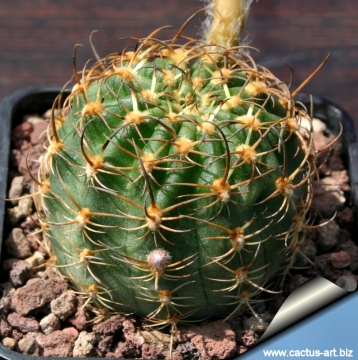
Echinopsis winteriana Photo by: Cactus Art

Echinopsis winteriana Photo by: Cactus Art
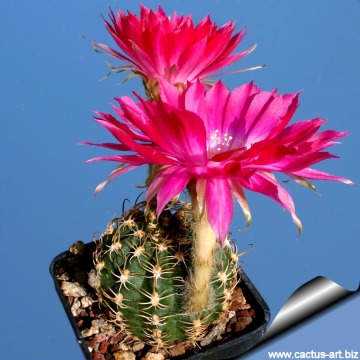
Echinopsis winteriana Photo by: Cactus Art
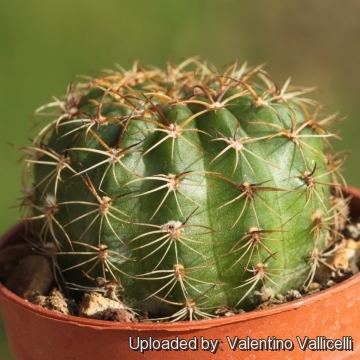
Echinopsis winteriana Photo by: Valentino Vallicelli
Cultivation and Propagation: Echinopsis winterianaSN|9514]]SN|9514]] grows rather slowly and it is sensitive to overwatering (rot prone) and needs a very good drainage to avoid rotting, but requires more moisture than true desert cacti to grow and produce flower. It is a very easy flowerer, if you keep it reasonably cool and absolutely dry during winter and lots of fresh air and sunshine tends to produce better plants and more flowers.
Soil: Use a loose well drained cactus mix.
Repotting: It require a deep pot suited to accommodate the swollen root, repotting with fresh potting-mix should be done every other year or when the plant has outgrown its pot. However, repotting doesn't necessarily mean they'll need larger containers.
Sun Exposure: Light shade when young, full sun later. Outside it likes strong sunshine, but is tolerant and do well with light shade during the hot Summer months. Tends to bronze in strong light, which encourages spine production.
Hardiness: It is cold resistant to -10° ( or even less depending on clones) for short periods of time. It will show its flowers only if we provide an adequate winter rest period.
Watering: Water regularly through the growing season. This can be done weekly or more frequently during the summertime, if the weather is sunny enough, but allow to dry fully before watering again. Kept this way, plants will show a healthy growth. Keep rather dry as soon as the temperature starts dropping in October and keep it dry in winter. The plant survives outside without protection in winter but is then somewhat prone to rot, too.
Fertilization: Give an occasional high potassium liquid feed during the active growing period.
Garden uses: It is a fine plant for a rock garden or container, contrasts well with agaves, yuccas, and low-growing flowering plants.
Pest and diseases: They are generally fairly easy to grow, especially if kept pest-free. They are susceptible to, scale insects and spider mite. Watch carefully for infestations of stem and root mealy bugs, and damage from these may well initiate fungal attack.
Propagation: Seeds, also can be grown from cutting as it branches from the base. Take cuttings spring or summer, let them dry till the ends callous well. Then replant them in fresh cactus soil that is ever so slightly moist, and keep it that way till they root. Surface sowing is the best; seeds germinate in 14-28 days at 20° C , remembering that seedlings dislike strong light and dry conditions.
| Your Actions | |
|---|---|
| Back to Echinopsis index | |
| Back to Cactaceae index | |
 |
Back to Cacti Encyclopedia index |
Privacy stantement - Terms and conditions - How to cite - About us - Feedback - Donate



